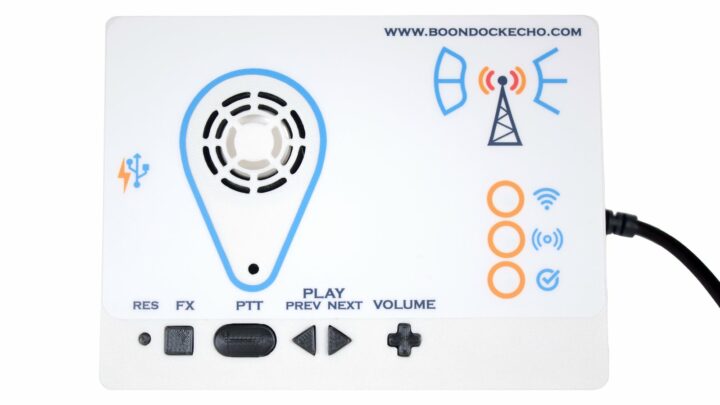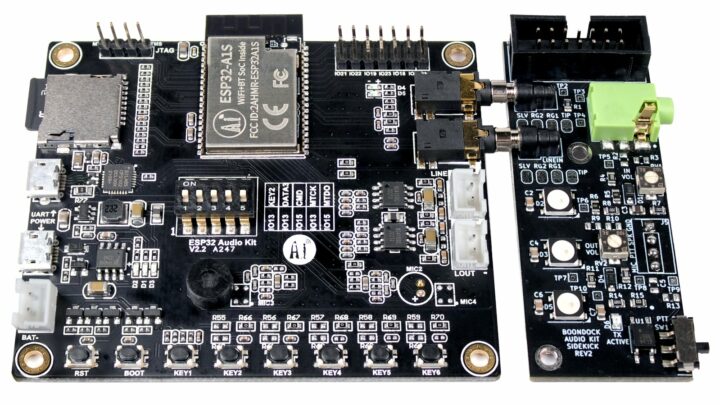The Boondock Echo is an open-source, internet-backed recording and playback device for two-way devices. It can denoise, transcribe, translate, and send emails on hearing keywords/call signs.
It is a low-cost solution for timeshift radio communication that enables users to monitor frequencies and record audio from a connected radio. Captured messages are uploaded to a server and transcribed using OpenAI. On the cloud server, the audio messages also pass through some DSP (digital speech processing) algorithms for noise reduction and volume normalization to enhance their clarity and usability.
The Boondock Echo is aimed at amateur radio operators and first responders in remote areas and during emergencies, situations where traditional two-way radios tend to be unclear and unreliable. Multiple devices can be linked together to form a ‘dockpack’ and monitor/record multiple frequencies at once.
Boondock Echo specifications:
- Mainboard – ESP32-A1S (ESP32 Audio Kit) running at up to 240MHz
- Expansion Board – Boondock Audio Kit Sidekick board (for the K-type cable and 3.5mm audio-out jack)
- Storage – MicroSD card slot
- USB – micro-USB (power-only), micro-USB (power, USB-to-UART)
- I/O – 3.5mm TRRS audio jack, walkie-talkie K-type two-pin cable
- Misc. – Power switch, on-device playback, online playback, transcription, translation, keyword detection, multicolored LEDs (Wi-Fi, audio, and device status)
- Buttons – Push-to-talk (PTT), volume, prev, next, function, reset
- Recording
- Format – .wav
- Time – 260 hours
- Supported Protocols – Email, IFTTT
- Battery – optional, built-in battery
- Dimensions – 120 x 90 x 30 mm
- Enclosure- 3D-printed enclosure
The ESP32-A1s at the core of the Boondock Echo is an audio development kit with onboard wireless connectivity aimed at audio and audio IoT applications. The ESP32 module is responsible for recording audio, running the offline interface, and playing back messages locally.
The Boondock Echo web application is hosted on AWS and provides advanced audio transcription and enhancement features supported by the device. To gain access to the Echo’s advanced features, you will need to either set up your server or purchase a subscription from the Boondock website (once manufacturing is complete). All Boondock Echo purchases come with a 1-month Advanced User subscription, and although you can set up your own server, developers say it may end up being much more costly and time-consuming than buying a subscription.
The Boondock Echo is an open-source project. The hardware files, bill of materials (BOM), on-device software code, and 3D files for the enclosure are available on GitHub. It is priced at $159 (plus a shipping fee of $8 US and $18 Worldwide), with orders projected to ship by July 15, 2024.
The project has been successfully crowdfunded and has far surpassed its goal at the time of writing. Still, you can learn more about the Boondock Echo and what it has to offer on CrowdSupply.

Tomisin is a writer specializing in hardware product reviews, comparisons, and explainers. He is very passionate about small form factor and single-board computers.
Support CNX Software! Donate via cryptocurrencies, become a Patron on Patreon, or purchase goods on Amazon or Aliexpress








Is it good enough for over-the-air DJing? /s
I mean I’m actually interested in making my own DSP and tried to work in a company for that
Hi, I am developer of Boondock Echo firmware. I wont recommend this for Music. its low bitrate audio.
For higher quality audio, I recommend this board. I know the developer of this board, and can connect you with him if you like.
https://www.cnx-software.com/2023/04/25/sonatino-raspberry-pi-zero-sized-esp32-s3-audio-board/
I’m not really sure how this thing even relates to ham radio. It requires an internet connection.
The description even makes itself defeating.
Last time I checked remote areas or emergency situation the internet doesn’t work.
If someone’s in a remote area and their actual ham radio that uses RF doesn’t work they have a problem and they need to educate themselves how to make it work.
This just seems like a plug and play tool for Sad Hams that want to record and report non-compliant use of Ham and GMRS spectrum.
It works offline – records/playback/etc.. But you can’t do things like email & IFTTT integration without the internet.
You can also spin up your own Raspberry Pi for your own server. That works offline. Could have a dozen of these pointed at a Pi on an ad-hoc network.